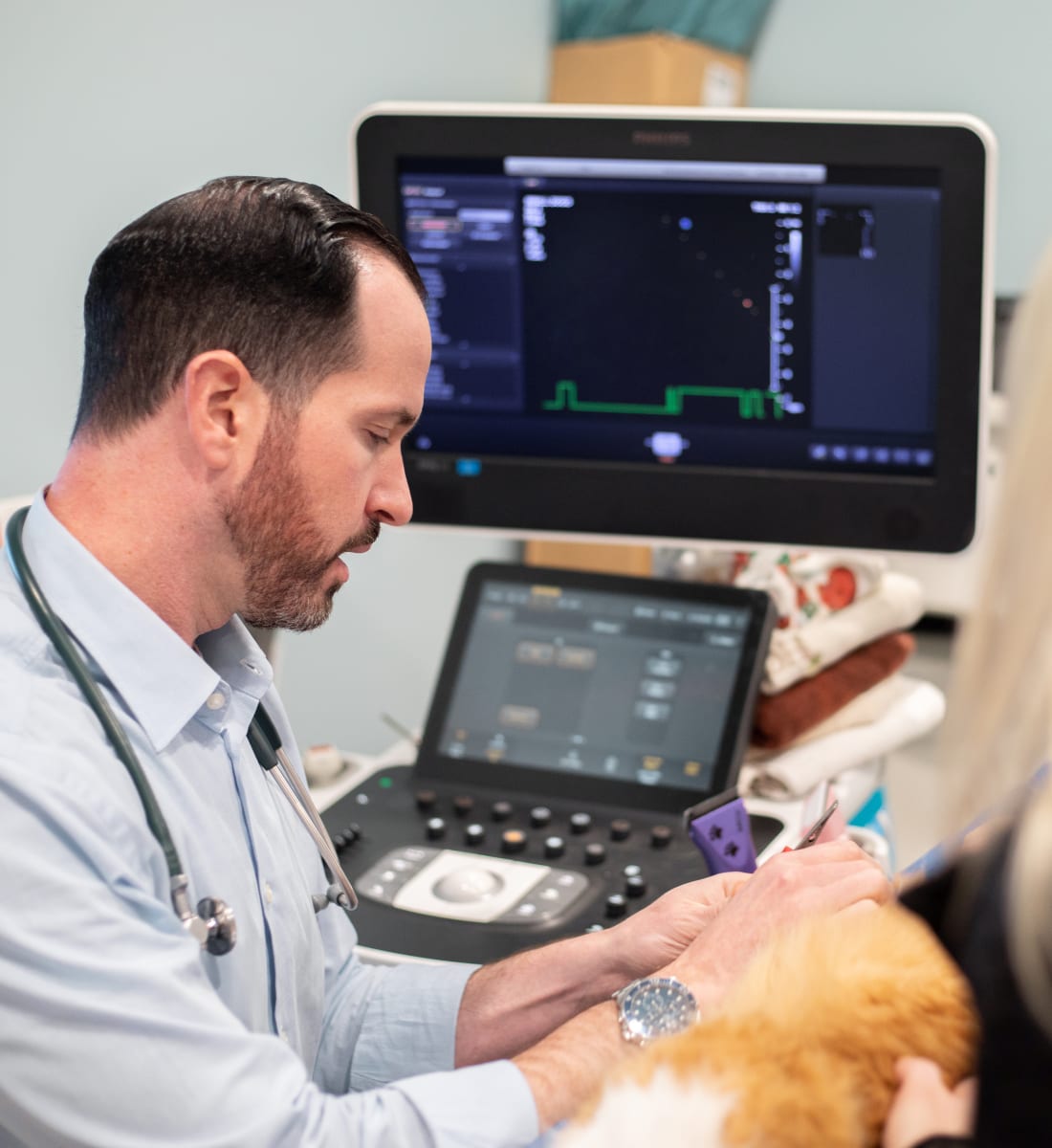Why CT Scans For Animals Are Becoming Standard in Modern Veterinary Medicine}
Wiki Article
The Duty of Ultrasound and CT Check in Modern Vet Practices: Insights From Experienced Professionals
In modern-day vet methods, ultrasound and CT scans considerably boost diagnostic capacities. These imaging methods provide essential understandings right into animal health and wellness, assisting therapy choices. Experienced experts acknowledge the distinct advantages of each modality. Ultrasound uses real-time assessments, while CT checks deliver complex physiological details. Understanding their applications and functions increases vital questions about their effect on patient end results and the future of veterinary diagnostics. What understandings can be gotten from their integrated usage?Understanding Ultrasound in Vet Medicine
Ultrasound is an essential diagnostic device in vet medicine, using a non-invasive technique to picture interior frameworks. This imaging strategy employs high-frequency acoustic waves to create real-time photos of tissues and body organs, allowing veterinarians to examine problems without surgical intervention. Typical applications consist of reviewing the heart, liver, kidneys, and reproductive organs, in addition to checking pregnancies.The procedure is relatively fast and can be done in numerous setups, making it an easily accessible option for veterinarians. Unlike radiography, ultrasound provides thorough details regarding soft cells and blood circulation, which is important for precise diagnoses.Veterinary experts rely upon ultrasound to detect irregularities such as lumps, cysts, and fluid buildup. Its capability to direct biopsies and other procedures even more enhances its utility in clinical practice. By using a secure and reliable way to check out internal anatomy, ultrasound has actually come to be a keystone of modern-day veterinary diagnostics.
The Advantages of CT Checks for Animal Diagnostics
CT scans deal significant advantages in vet diagnostics by supplying improved precision in identifying inner problems (CT Scans For Dogs). As a non-invasive imaging strategy, they ensure the safety and comfort of animals throughout evaluations. Additionally, CT checks help with a thorough evaluation of inner structures, permitting extra effective therapy planningEnhanced Diagnostic Accuracy
Improvements in imaging technology have considerably enhanced analysis precision in veterinary medication, especially via using CT scans. These scans provide detailed cross-sectional pictures of an animal's inner structures, permitting vets to recognize abnormalities with precision. The high resolution and three-dimensional capacities of CT imaging facilitate the discovery of problems such as lumps, fractures, and internal bleeding that might be missed out on with conventional imaging approaches. Additionally, CT scans can help in pre-surgical planning by providing an extensive view of anatomical relationships. This degree of detail not just enhances the precision of diagnoses but likewise help in tailoring reliable therapy plans. Subsequently, the assimilation of CT innovation right into vet practices is transforming the landscape of animal medical care, enhancing outcomes for individuals.Non-Invasive Imaging Strategy
The introduction of non-invasive imaging techniques has actually transformed animal diagnostics, with CT scans becoming a noticeable device in veterinary practices. These scans offer high-resolution, cross-sectional pictures of an animal's internal structures, permitting veterinarians to analyze complex conditions without the requirement for intrusive procedures. The advantages of CT scans include their capability to spot lumps, fractures, and internal blood loss with remarkable accuracy. In addition, they facilitate the examination of soft cells and organs, enhancing diagnostic abilities. The speed of CT scanning allows fast decision-making, which is crucial in emergency situations. By reducing tension and pain for the animal, CT scans add to a much more humane strategy to diagnostics, inevitably improving treatment results and advancing veterinary treatment.Comprehensive Internal Evaluation
A comprehensive internal assessment is necessary for precise medical diagnosis and effective treatment in vet medicine. CT checks offer considerable benefits hereof, supplying in-depth cross-sectional images of a pet's internal frameworks. This sophisticated imaging modality enhances visualization of complicated anatomical areas, making it possible for veterinarians to identify problems such as lumps, cracks, and inner bleeding with greater precision. Additionally, CT checks promote the evaluation of conditions that might be testing to detect with traditional methods. The speed and accuracy of CT imaging also add to timely treatments, enhancing client outcomes. As veterinary practices significantly integrate CT innovation, the benefits of considerable inner evaluations become evident, enhancing the value of this device in modern vet diagnostics.Comparing Ultrasound and CT Imaging Techniques
While both ultrasound and CT imaging offer necessary functions in vet diagnostics, each technique provides unique advantages and constraints that can affect medical decision-making. Ultrasound is especially valued for its real-time imaging abilities, enabling vets to observe vibrant physical procedures. This method is non-invasive, mobile, and does not entail ionizing radiation, making it a safer option for both animals and clinicians. Nonetheless, ultrasound might have restrictions in envisioning certain physiological frameworks or deep tissues.Conversely, CT imaging provides comprehensive cross-sectional views of the body, permitting precise localization of abnormalities. It masters examining complex organs and structures, especially in the thorax and abdomen. CT scans need sedation or anesthetic in lots of cases and entail direct exposure to ionizing radiation. Ultimately, the option in between ultrasound and CT relies on the details clinical scenario, the location of interest, and the necessity of the diagnostic needs.Case Researches: Successful Medical Diagnoses Via Imaging
Study illustrate the substantial renovations in analysis accuracy attained with innovative imaging technologies like ultrasound and CT scans in vet methods. These improvements not just enhance the detection of different problems yet additionally facilitate reliable and prompt treatment strategies. Examining particular cases can highlight the transformative impact of these imaging strategies on veterinary medicine.Diagnostic Accuracy Improvements

Imaging Technology Advancements
As veterinary imaging modern technology proceeds to develop, its effect on diagnostic abilities ends up being progressively apparent. Current study highlight the effective application of sophisticated ultrasound and CT check strategies in recognizing complex conditions. For circumstances, a vet clinic used high-resolution CT scans to detect an uncommon kind of lung cancer in a pet, which standard imaging had actually missed out on. An ultrasound exam exposed a stomach mass in a cat, prompting timely medical intervention and a favorable end result. These advancements not just boost analysis precision but additionally make it possible for vets to create targeted therapy strategies. By leveraging innovative imaging innovations, veterinary experts are substantially enhancing individual treatment, leading to much more effective monitoring of different wellness problems in pets.
The Role of Imaging in Emergency Situation Vet Care
Imaging plays an important function in emergency veterinary treatment, offering veterinarians with essential details required to make rapid, enlightened decisions. In immediate situations, strategies like ultrasound and CT scans allow experts to swiftly analyze a pet's internal structures, identifying essential conditions such as inner bleeding, cracks, or body organ problems. These imaging techniques permit real-time examinations, assisting in timely treatments that can be life-saving. For instance, ultrasound is indispensable for assessing soft cells injuries and conditions like fluid build-up, while CT checks offer thorough photos of complicated anatomical structures, necessary for identifying injury cases. The speed and accuracy of these imaging techniques improve the veterinarian's ability to create effective therapy strategies, making certain the very best feasible results for their clients. The assimilation of sophisticated imaging technologies into emergency situation veterinary methods is not just beneficial however progressively necessary, as it improves analysis capacities and enhances total animal care throughout essential moments.
Training and Experience in Veterinary Imaging
Although innovative imaging strategies such as ultrasound and CT scans are important for reliable vet care, the effective implementation of these modern technologies heavily depends on the training and know-how of vet professionals. Proficient use imaging devices needs detailed understanding of makeup, pathology, and the principles underlying each technique. Vet specialists have to undertake specific training to accurately interpret imaging outcomes, which is crucial for diagnosing conditions and preparing treatment.Certifications and proceeding education in veterinary imaging enhance the abilities of professionals, enabling them to stay upgraded with technical improvements. Collaboration in between radiologists and vets commonly results in enhanced analysis accuracy, as specialists can offer insights into complicated instances. On top of that, sensible experience in managing imaging tools promotes self-confidence in its application. Inevitably, the top quality of vet imaging solutions is directly associated to the degree of training and know-how possessed by the experts utilizing these important diagnostic tools.Future Trends in Diagnostic Imaging for Animals
With the fast innovations in innovation, veterinary analysis imaging is positioned for substantial evolution in the coming years. Arising patterns indicate a shift towards more portable and easily accessible imaging modalities, such as handheld ultrasound tools, which can improve field diagnostics. Additionally, the assimilation of expert system is anticipated to change picture analysis, permitting for quicker and extra accurate analyses of results.Moreover, developments in 3D imaging techniques and calculated tomography will certainly provide veterinarians with even more extensive sights Cancer Veterinary Near Me of animal makeup, resulting in improved therapy strategies. Virtual fact modern technology may additionally play a role in surgical preparation and education, providing vets an one-of-a-kind point of view on intricate cases.As telemedicine continues to expand, remote examinations helped with by analysis imaging will certainly become extra common, enabling experts to help family doctors in real-time. Overall, these trends are set to enhance the performance and effectiveness of vet care, inevitably boosting pet results.Often Asked Concerns
Just How Much Do Ultrasound and CT Scans Price in Veterinary Facilities?
The costs of ultrasound and CT scans in vet facilities commonly range from $300 to $1,500, depending on variables such as area, clinic kind, and details procedures required for the pet's diagnosis and treatment.
Are There Any Dangers Connected With Ultrasound and CT Checks for Pets?
Ultrasound and CT scans normally present very little dangers to animals. Potential problems consist of sedation reactions and direct exposure to anesthetics. Veterinarians very carefully evaluate each case to minimize any dangers related to these diagnostic treatmentsHow Much Time Do Ultrasound and CT Procedures Generally Take?
Ultrasound treatments normally take about 30 mins to an hour, depending on the complexity. CT scans, being even more thorough, usually require 30 mins to 90 mins, including preparation and healing time for the pet.Can All Veterinarians Perform Ultrasounds and CT Scans?
Not all vets can perform ultrasounds and CT scans. Specialized training and accreditation are frequently needed to guarantee competency in these sophisticated imaging methods, which may restrict their availability to veterinarians with additional certifications and sources.What Kinds Of Pets Benefit A Lot Of From These Imaging Techniques?
Particular pet species, especially canines and pet cats, benefit considerably from ultrasound and CT scans. These imaging strategies enhance diagnostic accuracy for problems like lumps, inner injuries, and body organ problems, leading to better treatment outcomes and individual treatment. The high resolution and three-dimensional abilities of CT imaging promote the detection of problems such as lumps, fractures, and internal bleeding that could be missed with conventional imaging approaches. Situation research studies highlight the significant renovations in analysis accuracy attained through sophisticated imaging modern technologies like ultrasound and CT scans in veterinary methods. Improving diagnostic accuracy in veterinary methods has been substantially assisted by improvements in imaging technologies such as ultrasound and CT scans. Sophisticated imaging methods such as ultrasound and CT scans are vital for effective vet care, the effective application of these modern technologies heavily depends on the training and proficiency of veterinary experts. Veterinary professionals need to go through specific training to precisely translate imaging results, which is vital for detecting conditions and planning treatment.Certifications and proceeding education in veterinary imaging enhance the abilities of professionals, enabling them to stay updated with technical advancements.Report this wiki page